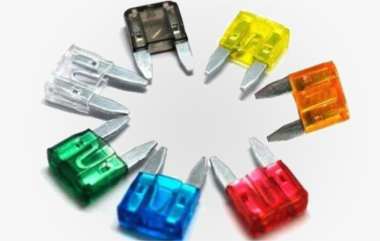
With the rapid advancement of automotive electronics and intelligent technologies, vehicle electrical systems are becoming increasingly complex, driving a growing demand for reliable safety components. Automotive fuses play a critical role as essential electronic elements that protect vehicle circuits by preventing electrical faults caused by current overloads and short circuits. Not only do they ensure the overall electrical safety of the vehicle, but they also help extend the lifespan of electronic devices. This article will cover the definition, types, working principle, features and advantages, as well as applications of automotive fuses.
Catalog
II. Main Types of Automotive Fuses
I. What Are Automotive Fuses?
Automotive fuses are circuit protection devices designed to interrupt electrical flow when the current exceeds a predetermined limit. Inside the fuse, a metal element melts when exposed to excessive current, thereby breaking the circuit and preventing damage caused by overloads or short circuits. These fuses are commonly used across various vehicle electrical systems—including lighting, audio, engine control units, and battery management systems—ensuring circuits are promptly disconnected under abnormal conditions to avoid fire hazards or equipment failure.
II. Main Types of Automotive Fuses
Depending on application requirements, automotive fuses can be categorized into several types:
· Blade Fuses: Widely used in low-voltage DC systems such as lighting and infotainment systems.
· Glass Tube Fuses: Compact and traditionally used in simple circuits.
· Semiconductor Fuses: Designed for high-power and high-voltage applications like battery management systems in electric vehicles.
· Smart Fuses: Equipped with integrated sensors and advanced circuitry for real-time electrical system monitoring and fault warning.
III. Working Principle
The core of an automotive fuse is its internal fusible element. When current flowing through the fuse exceeds its rated capacity, the fusible element heats up and melts rapidly due to thermal effects. This action breaks the circuit and prevents further damage from overload or short circuit conditions. This “fuse melting” mechanism is a passive yet highly effective means of circuit protection.
IV. Features and Advantages
· Fast Response: Quickly interrupts excessive current, minimizing damage to electrical components.
· Simple Structure and Low Cost: Suitable for mass production and easy to replace during maintenance.
· Reliable Safety: Effectively prevents electrical fires and equipment failures.
· Varied Specifications: Available in multiple ratings to meet the diverse voltage and current needs of different vehicle models and systems.
· Wide Compatibility: Applicable to both traditional internal combustion engine vehicles and new energy vehicles.
V. Applications
Automotive fuses are extensively used in the following areas:
· Passenger Cars: Protect lighting, infotainment, and other electrical systems.
· Commercial Vehicles: Safeguard heavy-duty equipment and high-power systems.
· Electric Vehicles (EVs): Provide safety protection for battery management systems and high-voltage circuits.
· Hybrid Electric Vehicles (HEVs): Protect battery packs and electric motor systems.
VI. Conclusion
As a vital safety component in automotive electronic systems, automotive fuses continue to evolve alongside advancements in vehicle technology. Understanding their definition, types, and working principles helps manufacturers and service professionals select the appropriate fuses to enhance vehicle safety and reliability. Looking ahead, intelligent and high-performance automotive fuses will be a major focus in the industry, driving the next level of innovation in automotive electrical protection technology.




